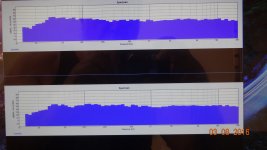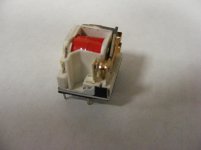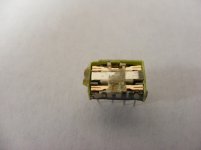Send them to me and tell her(?) you chucked themMe too, except I keep them for posterity. But then the Boss will tell you I never throw anything away.......
I return the question to you. We are talking about HF phenomena that are (i hope for you, at this level you do not need a tuner) at least < -40db under signal level. Means your headroom will be affected by < 0.008%, or, if you prefer, by 0.07dB. Go figure 🙂Is it so difficult to understand simple concepts?
Last edited:
We don't always think to write a book, each time we are working to tune-up our systems.Shame, would have been interesting to compare.
And, in professional area, we *print* measurements only under marketing department requests.
This said, as Mr. Marsh has the luck to own a rare JBL M2, may-be he will think to spend some hours to make and publish extensive measurements of those speakers.
One thing is missing in the ones provided by JBL is the step response. (And the group delay curve ?)
Last edited:
Only 30 years behind folks like Meyer's SIM or Smaart. You should be able to get a demo download of Smaart. All you need is a PC, stereo A/D and a mikeyrofone.
I think Behringer makes the cheapest adequate one.
Last edited:
I return the question to you. We are talking about HF phenomena that are (i hope for you, at this level you do not need a tuner) at least < -40db under signal level. Means your headroom will be affected by < 0.008%, or, if you prefer, by 0.07dB. Go figure 🙂
As HF harmonic distortion produces harmonics upper in the frequency range, which we are not supposed to can hear and that speakers will reject anyway because , usually, they do not produce any sound upper than 40KHz, don't you think it should be better to look at IM distortion in presence of HF components that can produce artifacts in the audible range ?
So no longer do we talk upper 40k. In my book, and yours (see quote), 40K and upper is HF in respect to audio.
Why fight this? did I offend you? or is my observation not true (that high frequency [with respect to audio] information may induce clipping when the amplifier is already near its limits) Or do you think that I'm some kind of troll (like some others here)?
Maybe this site will help Radio spectrum - Wikipedia it shows HF as 30Mhz and upper (well within the open loop GBW of many opamp'ss and even some power amp's).
Last edited:
Ok, no actual measurements to share then. Shame, would have been interesting to compare.
Compare to what? BTW - I did show it here at the time I did it. cant be going back finding data for each requester. Once is enough. Sorry.
But if there is enough interest.......
-RNM
Last edited:
32-bit process limit on 64-bit Windows is 4 GB. It's still 2 GB on 32-bit Windows. If the executable is 64-bit itself then the sky is the limit.
Cooledit was able to expand 10hr of mp3 to 44.1/16 on XP circa 1998 and operate on the whole file, I assume via clever swap management since no filters or other effects operate on more than a small portion at a time. Many algorithms using Fourier techniques yield to overlap and add partitioning.
Last edited:
Well, what I do is I set the level to be about 1-2 dB higher for the one I like the most based upon price or looks. Then, I compare in DBLT fashion. I always like the one with higher level, so i buy that one. No peeking was used...THx-RNMarsh
LOLOL...You must have worked at a stereo store in a previous life Richard! The idiot salesman at a store I used to work at would do that...but more like 2-3 dB.
geeesh...
Howie
OK well I did find this --->
I found this one of the JBL M2..... raw spkr/room data measured at the listening seat. L and R speakers. No EQ applied. No roll off at high end.
I measured it at my listening location in my home. It was unusually flat 40Hz to 20KHz.
Looks like +-10dB to me,
Oh, Lord. i did not wanted to offence-you in any way.So no longer do we talk upper 40k. In my book, and yours (see quote), 40K and upper is HF in respect to audio.
Why fight this? did I offend you? or is my observation not true (that high frequency [with respect to audio] information may induce clipping when the amplifier is already near its limits) Or do you think that I'm some kind of troll (like some others here)?
We were talking about distortions issues due to HF (harmonics and IM) that can be heard down to, say, 0.05%. IE -66dB.
Note that 1dB was defined to be the slightest level difference one can notice.
You worried about the impact of such a distortion level on the headroom. I just tried to show-you the scale to demonstrate that such added distortions have NO real impact on the headroom. If you only keep 1dB of head room, that you can consider as a full red limit, it will not change anything in this aspect, because the added levels of the distortions are totally negligible in regard of the total level. While, some added distortions can make-you feel , on the contrary that the power is increased.
Is-it more clear ?
As it is usually good to have a response curve slowly descending from bass to treble, i would say +- 5dB or less. That is remarquable, on my point of view, in a listening room out of free field or anechoic chamber and close miking.Looks like +-10dB to me,
Don't you agree ?
[edit] I noticed that the global curve follows more or less one of the the Fletcher and Munsnon curve. That will give a better balance at less level than 100dB. Good thing too.
Last edited:
Oh, Lord. i did not wanted to offence-you in any way.
We were talking about distortions issues due to HF (harmonics and IM) that can be heard down to, say, 0.05%. IE -66dB.
Note that 1dB was defined to be the slightest level difference one can notice.
You worried about the impact of such a distortion level on the headroom. I just tried to show-you the scale to demonstrate that such added distortions have NO real impact on the headroom. If you only keep 1dB of head room, that you can consider as a full red limit, it will not change anything in this aspect, because the added levels of the distortions are totally negligible in regard of the total level. While, some added distortions can make-you feel , on the contrary that the power is increased.
Is-it more clear ?
It just seems to me that your opinion turns with the sun.
And no you did not offend me, and I did not say that.
> You worried about the impact of such a distortion level on the headroom
Not true, I noted that frequencies of 40K and up might do so
And yes you (as in the quote) did say 40k and up.
> Is-it more clear ?
Yes, And I will no longer respond to this nonsense (at the least for me).
Last edited:
Sorry to say this, but, not understanding this evidence with is everything BUT a nonsense, you just make a fool of yourself.It just seems to me that your opinion turns with the sun.
And no you did not offend me, and I did not say that.
And yes you (as in the quote) did say 40k and up.
And I will no longer respond to this nonsense (at the least for me).
Somebody else, with a better English than mine will try to show-it to you in a more understandable way ?
Sorry to say this, but, not understanding this evidence with is everything BUT a nonsense, you just make a fool of yourself.
Somebody else, with a better English than mine will try to show-it to you in a more understandable way ?
FDW is not worried wrt headroom because of the (maybe) 1% additional IMD but instead because of the signal level above 20 kHz.
That´s why i mentionend the NOS cd-player as an example. A NOS-player will have the first mirror image spreading around 44.1 kHz, so it just depends on the level at 15 kHz - 20 kHz contained in the recorded.
If no steep analog low-pass filter is present (in contrary to the old days) these signals will be present at the NOS-player output additionally as signals from 24.1 kHz - 29.1 kHz and their amplitude will be only attenuated by the overlayed sinx/x due to the zero-order-hold in the NOS-player.
And on a totally different subject, relays for audio...
First picture is of a typical small relay. It has silver plated copper contacts. The idea is that if you use it for small signals the silver will give good low level performance. When used for larger signals and currents the silver plating will burn off and the copper contacts will handle higher current. So a used relay probably is not a good idea to re-purpose it for audio.
Second issue is to note the moving contact is attached to the steel magnetic armature. This will introduce distortion by passing your pristine audio signal coupled with the magnetic hysteresis distortion of the supporting armature.
The second relay if you look closely has bifurcated crossbar contacts that are silver or gold plated. More importantly the moving armature is off to the side and there is no parallel signal and magnetic path. (AGQ26012) This is a relay that is designed for low level signals and will fail if used for switching more than two amperes! It is rated to switch 10 uA or 10mV.
FYI!
First picture is of a typical small relay. It has silver plated copper contacts. The idea is that if you use it for small signals the silver will give good low level performance. When used for larger signals and currents the silver plating will burn off and the copper contacts will handle higher current. So a used relay probably is not a good idea to re-purpose it for audio.
Second issue is to note the moving contact is attached to the steel magnetic armature. This will introduce distortion by passing your pristine audio signal coupled with the magnetic hysteresis distortion of the supporting armature.
The second relay if you look closely has bifurcated crossbar contacts that are silver or gold plated. More importantly the moving armature is off to the side and there is no parallel signal and magnetic path. (AGQ26012) This is a relay that is designed for low level signals and will fail if used for switching more than two amperes! It is rated to switch 10 uA or 10mV.
FYI!
Attachments
Compare to what? BTW - I did show it here at the time I did it. cant be going back finding data for each requester. Once is enough. Sorry.
But if there is enough interest.......
-RNM
The speaker article that was under discussion at the time, comparing LS50s etc...
Thanks for finding the measurements! 🙂
The added *level* to the signal level is usually negligible, as long as HF parasitics are in concern, no ?FDW is not worried wrt headroom because of the (maybe) 1% additional IMD but instead because of the signal level above 20 kHz.
And, as a content of digital sources as well (brick wall filters), no ?
Now, if it is part of the signal itself (which mike ?) it ... is part of the signal, it is an other story. And we should worry about our tweeters.
Talking about head room, nothing to worry about this as long as you don't clip for any digital signal at 100%.
May-be we are not talking of the same thing, after all.
Last edited:
- Status
- Not open for further replies.
- Home
- Member Areas
- The Lounge
- John Curl's Blowtorch preamplifier part III


